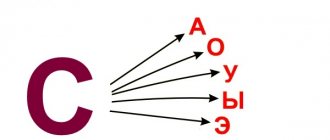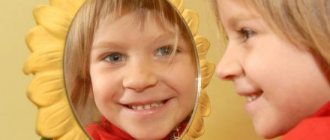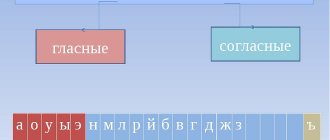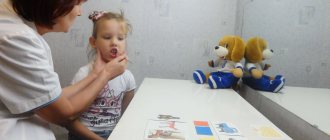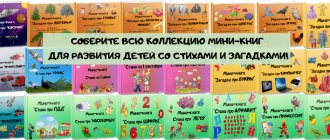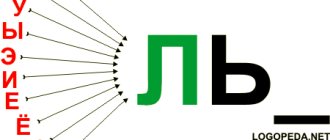After the stage of sound production, they move on to consolidating it in coherent speech. This is one of the most difficult stages, because you need to teach the child the skills of self-control of speech. The longer the incorrect pronunciation persists, the more difficult it will be to form the correct articulatory pattern. Automation of the sounds Ш and Ж and other phonemes that have similar characteristics is carried out separately. This is done to prevent their mixing.
It is worth moving on to the automation stage only after the child has managed to pronounce the desired sound correctly in isolation. After pronunciation is established, they move on to practicing it in syllables. All work on fixing sound in coherent speech is based on the principle of gradual complication of speech material.
Working with sound in syllables
Automation Ш, Ж in syllables is carried out in the following order:
- straight lines (SHA, ZHA, etc.);
- reverse (ASh, etc.), the sound Ж in these syllables is not practiced, because it is “stunned”;
- between vowels (ASHA, AZHA, etc.);
- with a combination of consonants (SHKA, ZhDA, etc.).
Tasks for children to reinforce sounds must be accompanied by visual material. Be sure to do articulation gymnastics at the beginning of the lesson to prepare the speech apparatus.
Isolated pronunciation is added to the practice of phonemes in straight syllables. Speech material is also gradually increased in volume: when moving on to a new type of syllables, first add 1-2 tasks with already worked out combinations.
Examples of tasks
To consolidate the correct pronunciation of syllables, the speech therapist uses special paths, “walking” along which the child pronounces the desired combination of sounds. At the beginning of the work, the adult gives a sample of correct pronunciation, then pronounces the material together with the child. Then the baby repeats on his own.
Examples of syllabic tracks:
- SHA-SHO-SHU-SHI;
- ZHA-JO-ZHU-ZHI;
- SHA-ASH-SHU-ISH;
- AZHA-OZHO-ZHU, etc.
At this stage, pure tongues are used. They are aimed not only at practicing correct pronunciation of syllables, but also at gradually introducing sound into words.
Examples of pure talk:
- SHA-SHA-SHA - we bathe the baby;
- SHO-SHO-SHO - rest well;
- ZHA-ZHA-ZHA - we saw the Snake;
- ZHU-ZHU-ZHU - I look at the sun.
When automating a certain phoneme, especially at this stage, try not to use words that have a sound with similar characteristics. After the child correctly pronounces Ш and Ж in syllables, the speech material becomes more complex and the stage of consolidation in words begins.
Notes on differentiating sounds in writing [Ш] - [Ф]
Topic: Differentiation in writing of paired voiced and voiceless consonant sounds [w]-[zh] letters in writing
Lexical topic Winter sports, Olympic Games in Sochi 2014; Grade 2 NHP (FFN) mixed dysgraphia
Type of lesson: Corrective and developmental lesson. The purpose of the lesson is to develop the ability to distinguish between the sounds [w] - [z] in words, phrases, sentences and letters in writing.
Tasks:
Correctional and developmental:
- consolidate children's knowledge of consonant sounds and letters SH-Zh;
- introduce children to the comparative characteristics of the sounds [SH] [Zh], the norms of their articulation;
- learn to identify sounds [zh], [sh] in words, phrases and sentences, correlate sounds with letters;
- provide and regulate the general energetic background against which all mental functions develop.
Educational:
- develop skills in sound-letter analysis and synthesis;
- improve the dynamic and static organization of movements (judgment);
- form voluntary auditory and visual perception, attention and memory;
- contribute to the updating and enrichment of the vocabulary with the letters w, zh in expressive speech on the lexical topic: “Winter sports”, “Olympic Winter Games in Sochi”;
- improve reading and writing skills of words with the letters w, z, and the ability to work with texts;
- develop the ability to compose phrases, consolidate knowledge of spelling norms;
- form grammatical stereotypes of word formation in expressive speech;
- expand schoolchildren’s understanding of the XXII Olympic Winter Games
Educational:
- develop self-control skills;
- cultivate a sense of pride in one’s homeland;
- improve the ability to evaluate the results of work on a task;
- cultivate a culture of behavior during front-line work and individual work;
- develop the ability to listen and hear each other, work in a team;
- to ensure interest in logopedic classes and a healthy lifestyle culture;
- cultivate a polite attitude towards a friend.
Equipment: profiles of sounds and letters w, zh, individual cards with tasks, soft toy White Bear, traffic lights, symbols of the Olympic Games, pens, markers, hearts for reflection (red, blue, black), vitamins, visual teaching aid “Winter views” sports”, funny tongue.
1 Organizational start of the lesson
The long-awaited bell rang and the lesson began.
1.1 Greeting guests
We welcome guests Dear teachers all familiar strangers Kind and cheerful
1.2 Rule of speech
Every day, always, everywhere, in class, in games, It’s true, we say clearly, We are not in a hurry.
1.3 Psychological attitude
During the lesson, our eyes look and see everything, our ears listen carefully and hear everything, the Head thinks well, and therefore we will succeed.
1.4 Articulation gymnastics using bioenergoplasty.
“Smile” “Tube”, “Into delicious jam”, “Cup”, “Swing”, “Horse”
1.5 Sound gymnastics.
A, O, U, M, Pf,
1.5 Read-repeat game
The cards are printed on red paper. This task was sent by athletes from America. Read the line, repeating after each next word all the previous words. For example, pear, pear - circled, pear - circled - champignon, etc. Read all the previous words as quickly as possible, but at the same time understand their meanings. Do the same with other lines.
| pear | circled | champignon | picturesque | width |
| joke | was in a hurry | lark | wide | embroidery |
| trousers | planted | rose hip | tenacious | car |
| cold | listened | scissors | funny | home |
| fur coat | lying | water lily | fire department | spring |
| life | expected | panties | nimble | fizzybrew |
| gun | decided | pearl | passerby | expectation |
Well done! The warm-up is over.
2.0 Main part
2.1 Statement of the problem.
Formulating the topic of the lesson. Repetition of what has been learned. Clarification and comparison of the articulation of sounds [ш], [ж] Working with sound profiles. Today we are reinforcing the pronunciation of the sounds [zh], [w] in words, phrases and sentences.
Speech therapist: What sporting event in the world were discussed in the last lesson? Children: The Olympic Games are the most exciting sporting event in the world. L: How many of you know when the Winter Olympic Games took place? Children: in 2014. Speech therapist: in which country did they take place? Children: in Russia. Speech therapist: In what city? Children: in the city of Sochi. Speech therapist: February 7, 2014, the XXII Winter Olympics took place Speech therapist: What is depicted on the Olympic flag? Children: The Olympic flag features five intertwined rings. They symbolize the five continents. The green ring symbolizes Australia, the blue one represents Europe, the red one represents America, the yellow one represents Asia, and the black one represents Africa; or The five rings that adorn the Olympic flag serve as a symbol of the five inhabited continents of the globe. This means that athletes from all countries can participate in the games. Speech therapist: Who remembers the motto of the Olympic Games? Speech therapist: What were the three values of the Olympic movement? - Speech therapist. Who knows what the Olympic mascot is? D: 3 mascots - Snow Leopard, Polar Bear, Bunny
Updating basic knowledge.
I love to swim and splash where the water is cold. Tumble in heaps of snow, Where it is always, always winter. White fur and a layer of fat will help anyone out in trouble. (Polar bear)
And today a guest came to our lesson - the symbol of Sochi 2014 (White Bear) White bear - black nose, Loves winter and frost
2.2 Introduction to winter sports.
Visual and didactic aid “Winter sports”
2.4 Working with cards.
The next task must be completed using a green card. From what country did the task come to us? (Australia). Find and read two words in each line - the names of winter sports.
B r l r p d ski d l d p g o n k i z d S m p f k c k c o n e r y l v s p o r t D l w alpine skiing p rtvk
2.5 Development of fine motor skills. Su-jok
2.6 Differentiation of Zh-Sh in phrases.
Using blue cards, match the nouns and adjectives correctly. Athletes from Europe submitted tasks for our lesson.
Woolen track Clumsy snowflake Ski trainer Snowy scarf Sports slope Speed skating Magic bear
Answer: woolen scarf, clumsy teddy bear, ski slope, snowy path, sports equipment, speed skating, magical snowflake.
Physical education minute
Speech therapist: To be strong and healthy, you need to love sports. Exercise, don’t be lazy, and make friends with exercise.
Song by V. Vysotsky “Morning exercises”
2.7 Working with text.
The polar bear cub brought you the text, but some letters were lost. Insert the missing letters Ш or Ж. Cards are yellow. Which continent gave us the task?
Polar bear
The polar bear lives in the Arctic zone. It is considered the largest predator in the world. It feeds on fish, seabirds, seals and even small walruses.
They spend most of the year on the ice. Ice is the lifeblood of bears, this is how they get food. Thanks to their large paddle-like paws, they swim well and have iron muscles. But mostly they relax lying on the ice.
The bear is saved from the cold by a thick layer of fat and a skin with thick, warm fur. Even the soles of their paws are protected by fur.
The polar bear is listed in the International Red Book.
- Name words with the sound Ш, and now with the sound Zh. - Circle the letter Ж, cross out the letter Ш. - Read the resulting story. - Answers on questions. - Now try to retell it according to plan.
2.8 Speech development. Retelling the story. Plan (on the board)
1. Where do polar bears live? 2. What does a polar bear eat? 3. What saves a bear from the cold?
Lesson summary.
- Listen carefully to the questions, if you agree, raise the black light with the “+” sign, if you disagree, raise the “-” sign.
- Is the sound [sh] always soft?
- Is the sound [zh] always hard?
- Do we write the combination Zhi - Shi with the letter I?
- Winter sports: figure skating, hockey, football, speed skating?
- The motto of the Olympic Games is “Faster. Higher. Better"?
- Does the phrase magic snowflake have a sound (w) and a sound (zh)?
- Was the Snow Leopard our guest?
- To be strong, dexterous, and skillful, you need to play sports.
— Guys, what mark would you give for your work? Why? Raise hearts (red, green, black)
Reflection
We make friends with vitamins and grow healthy. We never lose heart, we live very cheerfully. (I'm handing out vitamins)
Author of the material: Plokhikh Galina Vladimirovna
Also on topic:
Differentiation of paired voiced-voiceless consonants
Working in words
You need to choose only those words that contain a practiced syllable. The work is carried out in the following order:
- the sound is at the beginning;
- in the middle;
- at the end.
Automation begins with words with forward and backward syllables. It is advisable to illustrate each name, invite toys to “visit” - all this will make the lesson not only more interesting, but also more effective.
Examples of exercises
Similar to the previous stage, in the first lessons the speech material is spoken by an adult, then together with the student, and then the child repeats it independently. Gradually, when there are more practiced words, the baby names them without prompting from the speech therapist.
At the stage of automation of phonemes in words, work is carried out in parallel on the development of phonetic-phonemic processes. The child is explained where the word has a beginning, middle and end. During the classes, word diagrams are drawn up and tasks for the development of auditory self-control are offered.
At the same stage of automation, the gradual introduction of the automated phoneme into coherent speech begins. They do this using the example of phrases, Ш or Ж can be either in one or in each word:
- Repetition of words:
SHA: ball, cap, puck.
SHU: noise, fur coat, joke.
JA: toad, heat, sting.
And in this way they select words for each practiced syllable.
- The child is asked to listen carefully to the words and correct the adult. An adult deliberately makes mistakes in the pronunciation of the automated sound in some words. This task is aimed at developing auditory control of speech.
- Add the desired syllable to make a word. Pictures are used with children of primary and middle preschool age to make it easier for them to complete this task. For example, given an image of a cap and the second syllable – PKA. The child needs to add a syllable from the proposed options (SHA).
- Repetition of words with two sounds Ш or Ж. For example: bump, panties, kidding, etc.
- Repetition of phrases: On W: grandfather’s checkers, new hat, funny joke, sewing machine.
- On F: a beetle is buzzing, an orange jacket, liquid jelly.
When the child manages to pronounce the sound in words correctly, they move on to a more complex stage of correctional work - automating sounds in sentences. This block is longer in terms of the proposed material, because it is a preparation for the introduction of an automated phoneme into coherent speech.

